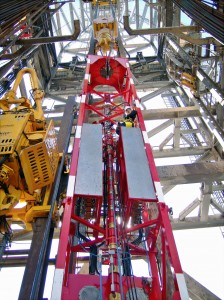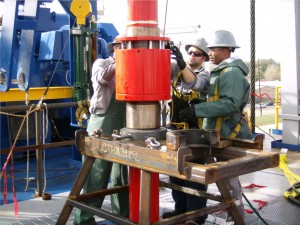New wireline pressure-control equipment breaks barriers in HPHT well
By Katie Mazerov, contributing editor

National Oilwell Varco (NOV) ASEP Elmar has announced the first field operation of its new high working-pressure-rated wireline pressure control equipment (WPCE) in an ultra-deep HPHT gas well on the Gulf of Mexico shelf. In development since 2010, the system was designed for pressures and temperatures up to 30,000 psi and 300°F, created in response to the growing need among operators for technologies that address ultra-high pressures.
The system was used in a well off the coast of Louisiana, marking the first time WPCE has been deployed with such a high working pressure, said NOV ASEP Elmar’s sales and marketing director Andrew Douglas. The equipment, nicknamed NOLA (for New Orleans, La.), was initially pressure-tested hydrostatically by a team of engineers at 45,000 psi in a subsurface 60,000-psi test bay at the NOV ASEP Elmar headquarters in Aberdeen. It was later pressure-tested in a gas environment up to 30,000 psi and 300°F. The rigorous testing phase was conducted over several months.
“Because there was no precedent for this equipment, our engineers had to come up with a design that is completely different than anything the industry has seen,” Mr Douglas noted. “Up until now, most WPCE was designed in accordance with American Petroleum Institute (API) standard 6A, the closest standard available for this type of equipment in terms of strength and thickness required to contain a certain amount of pressure. In going above a test pressure of 30,000 psi, however, the required thickness goes up exponentially, and it becomes practically impossible to design anything in line with API 6A that can be tested above 35,000 psi.”
Regulatory agency approval
In a highly unusual procedure, the company sought approval for the new materials and a proposed design methodology from API, the former Bureau of Ocean Energy Management, Enforcement and Regulation (BOEMRE) and the Bureau of Safety and Environmental Enforcement (BSEE), in a joint approach with the operator. “It is unusual to deal directly with regulatory agencies in the design of pressure-control equipment, but the operator wanted to make sure that all relevant agencies were aware of the technology being used for the challenging well, as did we,” Mr Douglas said.
Since conventional design methods are not practical for use at such extreme pressures, the equipment uses a solution of annealed and age-hardened Nickel alloy. This gives rise to the need for a new way of testing the integrity of the equipment to prevent potential failures, Mr Douglas explained. The testing involves the measurement of the lengths of microscopic fractures that grow inside the equipment as the pressure cycles during the operation. When fractures near the critical length, the affected component can be taken out of service.

NOV ASEP Elmar also designed new rams and a new type of patented ram seal called the Constrictor that were extensively tested to ensure the well would be safely controlled in the event of a blowout preventer closure. All equipment was third-party witness tested and certified, and a third-party representative remained at the manufacturing location during the long test phase.
The system includes a significant amount of redundancy to cope with unexpected equipment malfunction. “For example, as the electric line cable moves in and out of the well, a grease injection head seals around the cable,” Mr Douglas said. “At more normal pressures, if the injection head were to have a problem, the client would close or pack off while the injection is brought back into operation. With these kinds of pressures, however, that is not acceptable, so a lot of components, like the entire grease injection system, are redundant. For these high-pressure wells, we cannot contemplate dealing with any type of hydrocarbon release, so we need to have redundancy on everything.”
Click below to see a video demonstrating NOLA.
[flv flashvars=”file=https://drillingcontractor.org/wp-content/uploads/2012/06/video-hpht.flv&&image=https://drillingcontractor.org/wp-content/uploads/2012/06/poster-hpht.JPG”]https://drillingcontractor.org/wp-content/uploads/2012/06/video-hpht.flv[/flv]




